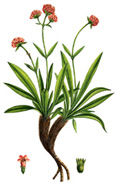| Latin Name | Nardostachys jatamansi DC. (Valerianaceae ) |
| English Names | Musk root, Indian spikenard, Indian Nard |
| Sanskrit Names | Jatamansi, Bhutajata, Tapasvini |
| Hindi Names | Jatamansi, Bal-chad |
 History: It has from a very remote period been in use among the Indians as a perfume and medicine. It is mentioned by Susruta in a prescription for epilepsy and is prescribed by Indian physicians as a nervine tonic and carminative and aromatic adjunct in the preparation of medicinal oils and ghees. N.j. is the Nardin of Dioscorides, which the writer tells us, was also called Gangitis because the Ganges flowed from the foot of the mountains where the plant grew. Arabic and Persian physicians call this plant Sumbul-i-Hindi, "Indian Spike", to distinguish it from their Sumbul-i-Rumi or Ikliti (Valeriana celtica), the root of which is used in Turkey and Egypt as a perfume. Distribution: Found in the alpine Himalayas from Punjab to Sikkim and Bhutan, at altitudes of 3,000-5,000 m. Habit: N.j. is an erect perennial herb, with a long, stout and woody rootstock. Its radical leaves are elongate and spathulate, its cauline leaves are sessile and oblong or sub-ovate; the flowers are rosy, pale pink or blue, in dense cymes. The drug consists of short, thick, dark grey rhizomes crowned with reddish brown tufted fibrous remains of the petioles of the radical leaves. Principle constituents: Jatamansone, Jatamanshic acid, Virolin and its diastereomer. Indications: Traditionally the drug has been used as a herbal CNS drug in epilepsy, hysteria, and convulsions. The oil possesses antiarrhythmic activity with possible therapeutic usefulness in cases of auricular flutter. Product range: Abana, Mentat, SportsCare cream, HairCare complete, HairCare cleanser |
|